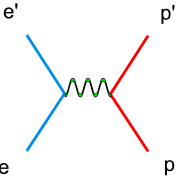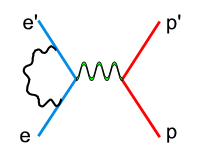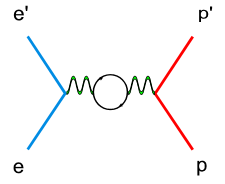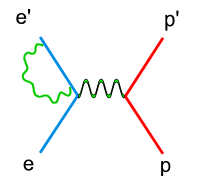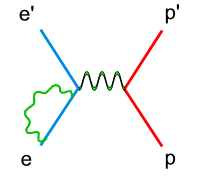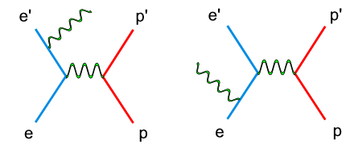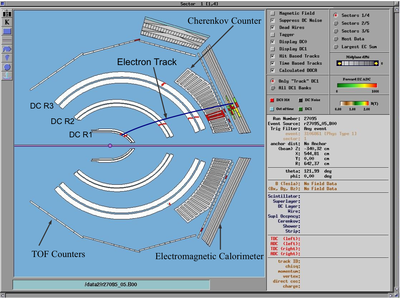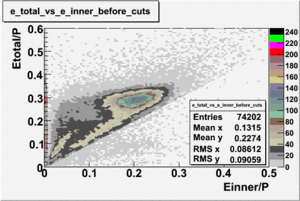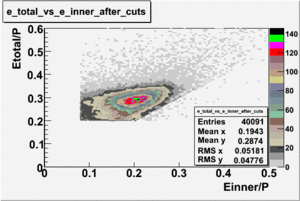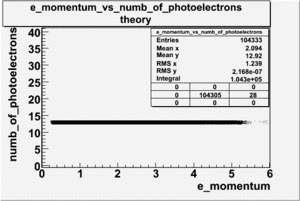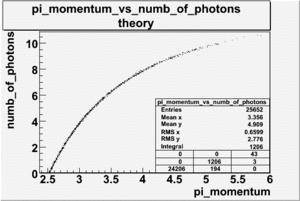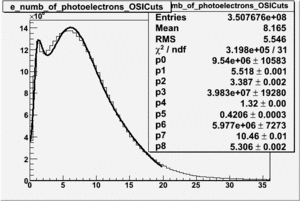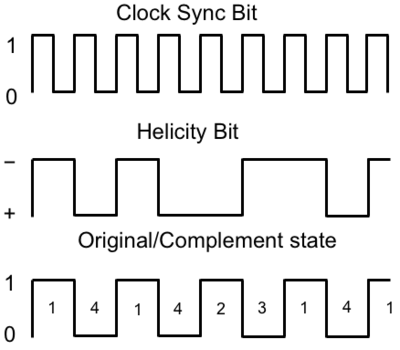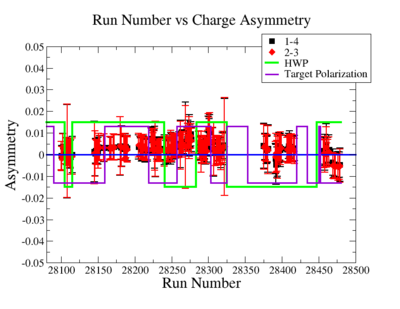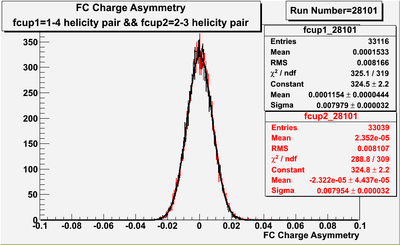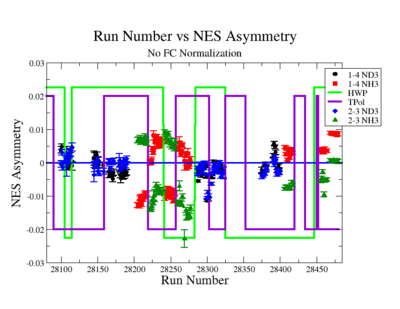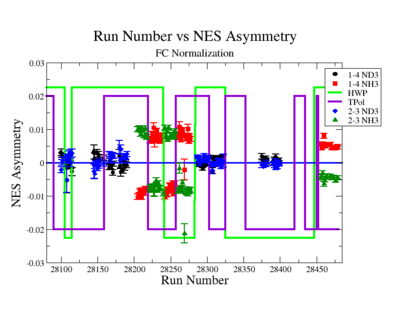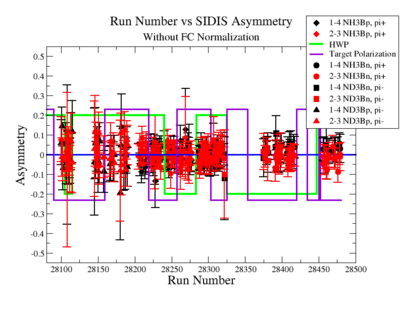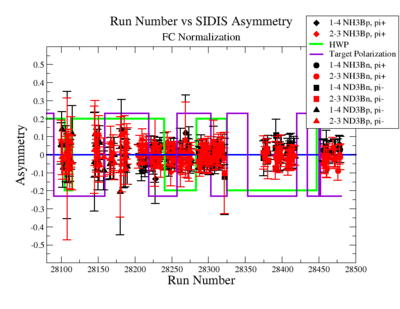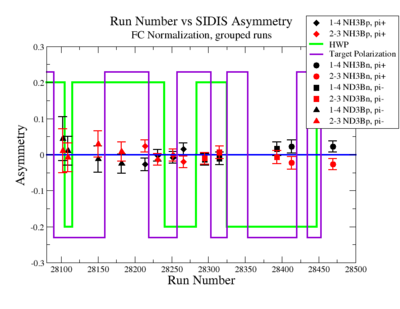Difference between revisions of "Tamar AnalysisChapt"
| Line 506: | Line 506: | ||
|'''Table 4.4.''' SIDIS Asymmetries for <math>x_{B}=0.3</math> and <math>x_{B}=0.4</math>. | |'''Table 4.4.''' SIDIS Asymmetries for <math>x_{B}=0.3</math> and <math>x_{B}=0.4</math>. | ||
|}<br> | |}<br> | ||
| − | + | In addition to <math>x_{B}</math>, the data has been subdivided for the fraction energy of the observed final state pion(<math>z</math>). <math> A_{NH3}^{\pi^+,hel13-hel24}</math> asymmetries for three <math>z</math> are shown in Table 4.5.<br> | |
| − | <math> A_{NH3}^{\pi^+,hel13-hel24}</math> | + | {| border="1" style="text-align: center;" align="center" |
| − | |||
| − | {| border="1" | ||
|- | |- | ||
| <math>z</math> || <math>X_B=0.3</math> || <math>X_B=0.4</math> | | <math>z</math> || <math>X_B=0.3</math> || <math>X_B=0.4</math> | ||
| Line 519: | Line 517: | ||
| 0.9 ||<math>(-355.44 \pm 200.23) \times 10^{-4}</math> ||<math>(-438.76 \pm 189.03) \times 10^{-4}</math> | | 0.9 ||<math>(-355.44 \pm 200.23) \times 10^{-4}</math> ||<math>(-438.76 \pm 189.03) \times 10^{-4}</math> | ||
|} | |} | ||
| − | + | {| border="0" style="background:transparent;" align="center" | |
| − | + | |- | |
| − | + | |'''Table 4.5.''' SIDIS Asymmetries vs <math>z</math>. | |
| − | + | |}<br> | |
| − | |||
| − | |||
| − | |||
| − | |||
| − | |||
| − | |||
| − | |||
| − | <math> | ||
| − | |||
| − | |||
| − | |||
| − | |||
=Results= | =Results= | ||
Revision as of 22:20, 25 April 2012
Data Analysis
In this chapter, we discuss the techniques used to analyze the data collected during the EG1b experiment and calculate semi-inclusive cross sections for the following reactions: and for NH3 and ND3 polarized targets respectively. The goal of this work is measure the fragmentation function depends on the Bjorken scaling variable () and the four momentum transfer squared () as well as evaluate the independence of the fractional energy of the observed final state hadron (). The fragmentation function ( ) can be expressed in terms of the ratio of the difference of polarized to unpolarized cross sections for the semi inclusive deep inelastic scattering for proton and neutron targets.
The CLAS Data Selection
The data files from the EG1b run were chosen for this analysis are listed in Table 1.1. During the experiment, 2.2 GeV, 4.2 GeV and 5.7 GeV longitudinally polarized electron beams were used on the polarized frozen ammonia NH3 and ND3 targets. This work will discuss the analysis of 4.2 GeV electron beam on hydrogen and deuteron targets. The collected data has been filtered by applying restrictions, which will be discussed in tin this chapter below. For the final results, the run sets were combined for each target type.
| Run Set | Target Type | Torus Current(A) | Target Polarization | Half Wave Plane(HWP) |
| 28100 - 28102 | ND3 | +2250 | -0.18 | +1 |
| 28106 - 28115 | ND3 | +2250 | -0.18 | -1 |
| 28145 - 28158 | ND3 | +2250 | -0.20 | +1 |
| 28166 - 28190 | ND3 | +2250 | +0.30 | +1 |
| 28205 - 28217 | NH3 | +2250 | +0.75 | +1 |
| 28222 - 28236 | NH3 | +2250 | -0.68 | +1 |
| 28242 - 28256 | NH3 | +2250 | -0.70 | -1 |
| 28260 - 28275 | NH3 | +2250 | +0.69 | -1 |
| 28287 - 28302 | ND3 | -2250 | +0.28 | +1 |
| 28306 - 28322 | ND3 | -2250 | -0.12 | +1 |
| 28375 - 28399 | ND3 | -2250 | +0.25 | -1 |
| 28407 - 28417 | NH3 | -2250 | +0.73 | -1 |
| 28456 - 28479 | NH3 | -2250 | -0.69 | +1 |
| Table 1.1. EG1b Runs used for Analysis (Run Sets, Target Type, Torus Current, Target Polarization, HWP). |
Radiative Corrections
In double spin asymmetry analysis the electron nucleon scattering process is given as an one photon exchange event, so called the Born approximation(Fig 1.1.1). In reality, there are multiple photon effects during the experiments. These high order processes, also called radiative effects, can be calculated and used to correct the cross section data.
There are two types of radiative corrections, internal and external. Internal radiative corrections describe the contributions, which took place during the lepton-hadron interaction. In first order approximation they include vertex photon exchange, self energy and vacuum polarization Fig. 1.1.2 .<ref name="RadiativeCorrections"> Nucleon Form Factors. In Scholarpedia, from http://www.scholarpedia.org/article/Nucleon_Form_factors#History </ref>
| Figure 1.1.2 Internal Radiation |
On the other hand, the external radiative corrections account for the Bremsstrahlung by the incoming and scattered electron and by the recoiling target nucleon Fig. 1.1.3.
One of the major advantages of the double polarization experiments is the minimum contribution from the radiative corrections. For the incident electron beam data the radiative corrections are less than 5%<ref>http://www.jlab.org/Hall-B/secure/eg1/EG2000/fersch/QUALITY_CHECKS/file_quality/runinfo.txt</ref>. Due to negligible contributions from the radiative corrections, they are not included in the double spin asymmetry analysis.
Particle Identification
The correct identification of an electron and a pion is the main requirement for the semi-inclusive analysis. The raw data collected during the EG1b experiment is converted into quantities, like momentum, energy, time-of-flight and etc. This information is used for the particle identification. In this chapter, we will discuss the cuts used for the electron and pion identification.
Electron Identification
The CLAS trigger system is is a coincidence of the negatively charged particle track detected in the drift chamber with hits in the electromagnetic calorimeter and cherenkov counter in time window Fig. 2.1. Unfortunately, the background negatively charged pions passing through the drift chamber that coincide with the noise signal in the cherenkov counter not related to the path in the wire chamber, but observed in the same CLAS sector can be misidentified as electrons. These background pions are the result of the quasi-real photoproduction, when the polar angle of the scattered lepton is approximately zero and is not accounted by the CLAS detector. In order to remove contamination due to those pions, geometrical and time matching between the cherenkov counter hit and the measured track in the drift chamber has been implemented in the data analysis. In addition, the pion contamination of the electron sample is reduced using the cuts on the energy deposited in the electromagnetic calorimeter and the momentum measured in the track reconstruction for the known magnetic field. The energy deposition mechanism for the pions and electrons in the electromagnetic calorimeter is different. The total energy deposited by the electrons in the EC is proportional to their kinetic energy, whereas pions are minimum ionizing particles and the energy deposition is independent of their momentum.
EC CUTS
The CLAS electromagnetic calorimeter was used to separate electrons from the pions. Electromagnetic calorimeter contains layers of lead-scintillator sandwichs composed of thick lead and thick scintilltaor. Each set of layers are subdivided into inner and outer layers that are named the inner and outer calorimeter respectively.
Electrons interacting with the calorimeter produce electromagnetic showers and release the energy into the calorimeter. The deposited energy is proportional to the momentum of the electrons. Fig. 2.2.1 shows the correlation of the inner and outer calorimeter electron candidate's energy measured by the calorimeter and divided by the electron's momentum reconstructed by the drift chamber. As shown in the figure, there is an island near , which contains most of the electron candidates as well as some regions below which will be argued are negative pions misidentified as electrons.
Pions entering the calorimeter are typically minimum ionizing particles, loosing little of their incident energy in the calorimeter at a rate of . Electrons, on the other hand, deposit a larger fraction of their momentum into the calorimeter. Energy deposition into the electromagnetic calorimeter is different for electrons and pions. Passing through the calorimeter pions loose about energy independent their momentum, producing the constant signal in the calorimeter around . In order to eliminate misidentified pions from the electron sample, following cut has been applied:
|
|
where represents particle momentum and - inner part of the calorimeter.
Since the energy loss of pions is related to the detector thickness the correlation can be established between the energy deposition into the inner and outer layers of the detector:
|
|
which gives the following cut for the energy deposition into the outer layer of the calorimeter:
|
|
|
Figure 1.2.2 vs before and after EC cuts (, for EC inner - ). |
Cherenkov Counter Cut
The Cherenkov counter has been used to separate electrons from the background negatively charged pions. When the velocity of a charged particle is greater than the local phase velocity of light or when it enters a medium with different optical properties the charged particle will emit photons. The Cherenkov light is emitted under a constant angle - the angle of Cherenkov radiation relative to the particle's direction. It can be shown geometrically that the cosine of the Cherenkov radiation angle is anti-proportional to the velocity of the charged particle
where is the particle's velocity and - index of refraction of the medium. The charged particle in time travels distance, while the electromagnetic waves - . For a medium with given index of refraction , there is a threshold velocity , below which no radiation can take place. This process may be used to observe the passage of charged particles in a detector, which can measure the produced photons.
The number of photons produced per unit path length of a particle with charge and per unit energy interval of the photons is proportional to the sine of the Cherenkov angle<ref name="Nakamure"> Nakamure, K., et al.. (2010). The Review of Particle Physics. Particle Data Group. J. Phys. G 37, 075021.</ref>
After deriving the Taylor expansion of our function and considering only the first two terms, we get following
The gas used in the CLAS Cerenkov counter is perfluorobutane with index of refraction equal to . The number of photoelectrons emitted by electrons is about . On the other hand, calculations show that the number of photons produced by the negatively charged pions in the Cherenkov detector is approximately . The theoretical results of the number of photons produced by the electrons and pions when passing through the Cherenkov counter are shown on Fig. 1.2.1.
| Figure 2.2.1 Theoretical Calculation of the Number of Photoelectrons for Electrons and Pions. |
The number of photoelectron distribution measured in the cherenkov detector and the energy deposition dependence on number of photoelectrons are shown on Fig. 2.2.2 and Fig. 2.2.3. One can see, that a single photoelectron peak is caused by the misidentified pions as electrons.
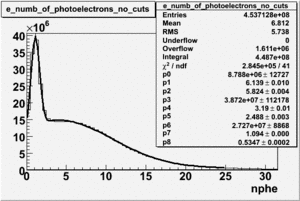
|
| Figure 2.2.2 The number of photoelectrons without cuts. |
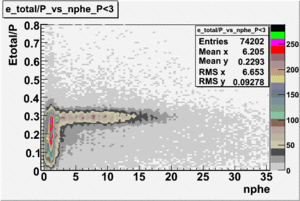
|
| Figure 2.2.3 The total energy deposited into the Calorimeter vs The Number of Photoelectrons. |
These negative pions are produced when lepton goes at polar angle close to zero and is not measured by the detector. In order to reduce the electron sample contamination due to those pions, geometrical cuts on the location of the particle at the entrance to the cerenkov detector and time matching cuts has been developed by Osipenko. <ref name="Osipenko"> Osipenko, M., Vlassov, A.,& Taiuti, M. (2004). Matching between the electron candidate track and the Cherenkov counter hit. CLAS-NOTE 2004-020. </ref> For each CLAS Cherenkov detector segment the following cut has been applied
where represents the measured polar angle in projective plane for each electron event. Cherenkov counter projective plane is an imaginary plane behind the Cherenkov detector where cherenkov radiation would arrive in the case if it moved the same distance from emission point to PMT, without reflections in the mirror system, - the polar angle from the CLAS center to the image of Cherenkov counter segment center and - the shift in the segment center position. In addition to geometrical cuts, timing cuts has been applied in order to perform time matching between Cherenkov counter and time of flight system.
The pion contamination in electron sample was estimated by fitting the number of photoelectron distribution with two Gaussian distributions convoluted with a Landau distribution, which is presented below<ref name="Lanczos"> Lanczos, C. (1964). A precision approximation of the Gamma function. SIAM Journal of Numerical Analysis, B1 86. </ref>:
It appears, that pion contamination in electron sample is before applying the hard cut on the number of photoelectrons produced in the cherenkov counter and after cut contamination is about (Fig. 2.2.4).
| Figure 2.2.4 The number of photoelectrons before and after OSI Cuts. |
Pion Identification
Charged pions are identified by a coincidence hit in the drift chamber and TOF counter. Pions are separated from the other charged particles by looking at the particle momentum versus the distribution. The particle velocity, , is calculated from the difference of the vertex start time and the time-of-flight measurement in the TOF system with the path length from the vertex to the Time-of-Flight counters. The mass of the charged particle can be identified by combining the particle with the particle momentum obtained from the tracking passing through the drift chamber in the known magnetic field. The particle mass in a magnetic field is given as
where is the mass of the charged particle, - its velocity, - particle momentum, - the path length from the vertex to scintillators and - the time of flight from the interaction vertex to the TOF system.
Using above information (particle momentum from the drift chambers and the timing information from the TOF system), the mass squared of the charged particle was calculated and is shown on Fig. 2.2.2. The pion mass band is around . To isolate charged pions from the rest of the particles a on vs momentum has been applied<ref name="Park2008" >Park, K., Burkert, V. D., & Kim, W. (The CLAS Collaboration). (2008). Cross sections and beam asymmetries for -> in the nucleon resonance region for . Phys. Rev., C77, 015208.</ref>.
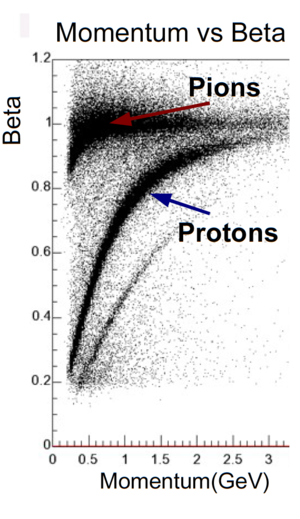
|
| Figure 2.2.1 The charged particle momentum vs distribution. |
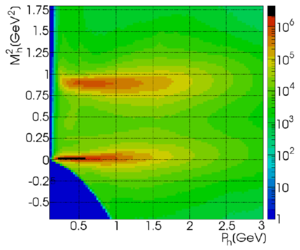
|
| Figure 2.2.2 The charged particle momentum vs mass squared distribution<ref name="Park2008" >Park, K., Burkert, V. D., & Kim, W. (The CLAS Collaboration). (2008). Cross sections and beam asymmetries for -> in the nucleon resonance region for . Phys. Rev., C77, 015208.</ref>. |
In addition of the charged particle velocity(), the fiducial volume cuts has been applied for the charged pion identification. Since the drift chambers and scintillators are used for pion detection, the polar angle range where pions are detected is much larger than for electrons. For EG1b experiment, pions were detected from to <ref name="Park2008" >Park, K., Burkert, V. D., & Kim, W. (The CLAS Collaboration). (2008). Cross sections and beam asymmetries for -> in the nucleon resonance region for . Phys. Rev., C77, 015208.</ref>. The pion identification code has been developed by Josh Pierce<ref name="PionCodeJosh"> Joshua Pierce. Pion Identification. From EG1 Hall-B http://www.jlab.org/Hall-B/secure/eg1/EG2000/josh/pion.cc </ref>
Specific Event Reconstruction Efficiency
The goal of this work is to measure the semi-inclusive asymmetry when an electron and a pion are detected in the final state. Pions of opposite charge will be observed using the same scintillator paddles by flipping the CLAS Torus magnetic field direction. Although, the pions will be detected by the same detector elements, the electrons will intersect different detector elements. As a result, the electron efficiency will need to be evaluated in terms of the electron rate observed in two different scintillator paddles detecting the same electron kinematics.
Inclusive Event Reconstruction Efficiency
The electron efficiency of individual scintillator detectors using the 4.2 GeV data for ND3 and NH3 targets is investigated below. Only the electron detection is required in the final state (inclusive case). The pion contamination in the electron sample was removed by applying cuts described above. The electron paddle numbers 10 (B<0) and 5 (B>0) were chosen respectively, because they contained the most electron events in a first pass semi-inclusive pion analysis of the data set. The electron kinematics (Momentum, scattering angle and invariant mass) for these scintillators is shown on Fig. 3.1.
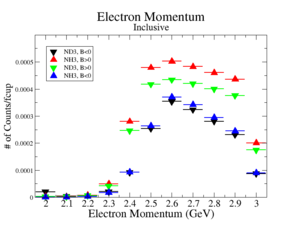 |
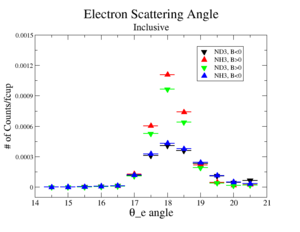 |
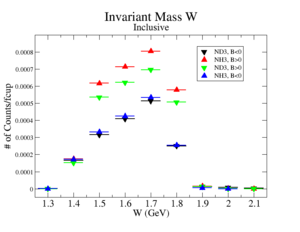
|
| Electron Momentum((NH3,B>0), (NH3,B<0), (ND3,B>0) && (ND3,B<0)) | Electron Scattering Angle ((NH3,B>0), (NH3,B<0), (ND3,B>0) && (ND3,B<0)) | W Invariant mass((NH3,B>0), (NH3,B<0), (ND3,B>0) && (ND3,B<0)) |
| Figure 3.1. Electron Kinematics. |
Ratios of the inclusive electron rate, normalized using the gated faraday cup, of scintillator paddles 5 and 10 were measured. The two ratios are designed to measure the CLAS detectors ability to observe the same electron kinematics using different detector elements positioned for opposite Torus polarities.
Notice the ratio is statistically the same, if the NH3 and ND3 targets are used for this ratio in a manner which will be similar to the semi-inclusive analysis.
The above ratios, which have been observed to be ammonia target independent, indicate a difference in an electron detector efficiency when the Torus polarity is flipped. In order to make detector efficiency the same for electrons, the ratios were used as a "correction coefficient". The "correction coefficient" for the case is and for the it is .
Exclusive and Semi-Inclusive Event Reconstruction Efficiencies
After establishing the electron efficiency for the selected paddle numbers, the measured single pion electroproduction rate was compared to the MAID 2007 unitary model that has been developed using the world data of pion photo and electro-production to determine the impact of using the above "correction coefficient". The model is well adopted for predictions of the observables for pion production, like five fold cross section, total cross secton and etc.
The MAID 2007 model has predictions of the total cross section for the following two cases, that are related to our work:
| + proton + neutron |
| + neutron + proton |
The ratio of the pions detected in the scintillator paddles, located between the Cherenkov counter and electromagnetic calorimeter, is shown on Fig. 3.2. The ratios were taken for four different cases. Assuming that, for the inbending case positive pions and for the outbending case negative pions have the same trajectories with the same kinematics. In addition, negatively charged pions in the inbending field and positively charged pions in the outbending fields are detected by the same detector elements.
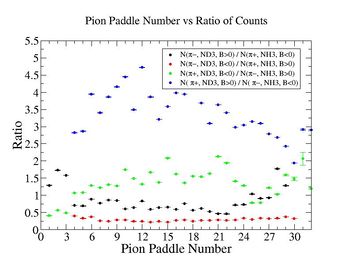
|
| Figure 3.2. Pion paddle number vs Ratio for Semi-Inclusive case. |
Using MAID 2007, the total cross section was calculated for the following invariant mass and four momentum transferred square values: and . <ref name="MAID2007" > http://wwwkph.kph.uni-mainz.de/MAID//maid2007/maid2007.html</ref>.
where is pion azimuthal angle in CM frame, - virtual photon polarization, - the energy difference of the initial and final state electron, - Four momentum transferred square, - electron scattering angle and - electron helicity. After applying corrections from the inclusive cases, the ratios have been compared to the results from MAID2007. The difference of the measured and MAID2007 model ratios for each pion paddle number is shown on Fig. 3.3. One can conclude from the Fig. 3.3 that the inclusive corrections do not impact single pion production for the exclusive cases.
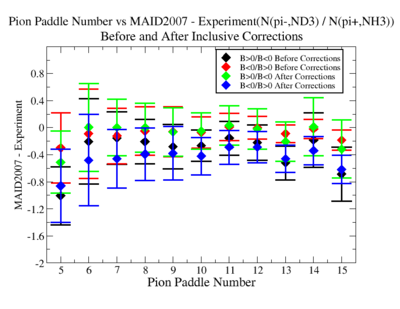
|
| Figure 3.3. Pion Paddle Number vs MAID2007 - Experiment() . The Black and red data represent B>0/B<0 and B<0/B>0 cases respectively before corrections. The green and blue points represent the ratios for B>0/B<0 and B<0/B>0 after inclusive corrections. |
Asymmetries
The double spin asymmetry measurements in this thesis are performed by comparing scattering events that occur when the incident probe spin and nuclear target spin are parallel to the scattering events that occur when the spins are anti-parallel.
Beam Charge Asymmetry
The helicity of the electron beam was flipped at a rate of 1 HZ. The helicity is prepared at the source such that helicity pairs are produced pseudo randomly. If the first electron bunch is pseudo randomly chosen to be positive (negative) then it is labeled as the original helicity state and denoted in software by a 2 (1). The next helicity state is prepared to be a complement to the first state and labeled in the software as either a 4, if the original helicity state was a 1 (negative), or 3 if the original helicity state was a 2 (positive). The helicity process is then repeated. Figure Fig. 4.1 illustrates the signals used to label helicity state. The clock pulse (SYNC) is used to indicate that a change in the pockel cell used to define the helicity state may have occurred. The helicity bit indicates the helicity state that was set. The original/complement pulse identifies if the state is an original or complement helicity state. All three bits are recorded in the raw data file for each event and then converted to the labels 1,2,3,4 during DST file production once the particles have been reconstructed.
| Figure 4.1. The Helicity State: A one bit signal from the beam injector gives the helicity information, whereas a sync bit with a 2 HZ frequency is generated at the same time and is equal to the helicity flip time. |
Two scalers were used to record several ancillary detectors, such as a Faraday cup and several PMTs mounted on the beam line, according to their helicity label. One of the scalers was gated by the DAQ live time in order to record beam conditions when the DAQ was able to take data and not busy recording data. The second scaler remained ungated. Both scalers recorded the SYNC and Helicity signals from the injector along with the counts observed from ancillary detectors during the SYNC interval. The Faraday cup signal recorded by the gated helicity scaler is used to normalize the events reconstructed during the same helicity interval. The beam charge asymmetry measured by the gated helicity scaler is shown in Fig. 4.2 as a function of run number. For each run number the gaussian fit was used to extract the mean values of the asymmetry and corresponding error(Fig. 4.3).
|
Figure 4.2. Run Number vs Beam Charge Asymmetry. The red data points represent beam charge asymmetry for the 2 - 3 helicity pair, whereas the black points - beam asymmetry for the 1 - 4 helicity pair. The green line shows the sign of the half wave plane (HWP) and the purple line - the sign of target polarization(TPol). |
|
Figure 4.3. Beam charge asymmetry for run #28101 using the gated faraday cup counts for two helicity pairs(1-4 and 2-3 helicity pairs). and . |
EG1b runs, with the same half wave plane, target type, target polarization and beam torus, have been combined. The beam charge asymmetries have been calculated for the each run group and are listed in Table 4.1.
| Run Group | Half wave plane(HWP) | ||
| 28100 - 28105 | +1 | ||
| 28106 - 28115 | -1 | ||
| 28145 - 28240 | +1 | ||
| 28242 - 28284 | -1 | ||
| 28286 - 28324 | +1 | ||
| 28325 - 28447 | -1 | ||
| 28449 - 28479 | +1 |
| Table 4.1. Run Group vs Beam Charge Asymmetry. |
Electron Asymmetry
A measurement of the electron cross section helicity difference needs to account for the possible helicity dependence of the incident electron flux ( Charge Asymmetry). Fig. 4.4 shows the reconstructed electron asymmetry before it is normalized by the gated Faraday Cup as a function of the run number for the 4.2 GeV data set. The reconstructed electron asymmetry can be defined following way:
| or |
where () represents number of reconstructed electrons in the final state for the positive(negative) beam helicity.
|
Figure 4.4. Run Number vs Electron Asymmetry before FC normalization. The red points represent reconstructed electron asymmetry for the helicity 2-3 pair and the black points - the helicity pair 1-4. The green line shows the sign of the half wave plane(HWP) and the purple line - the sign of the target polarization(TPol). |
Systematic effects on the asymmetry measurement may be investigated by separating the data into two groups based on which helicity state is set first. The first group(black data points) represents the electron asymmetry observed when the first (original) helicity state is negative and its complement state is positive(helicity state #1 - state #4). The second group(red data points) represents the asymmetry observed, when the first state is positive and the complement state is negative(helicity state #2 - #3). Both groups were divided into two subgroups based the target type used. The diamond points on the histogram represent the data for the NH3 target and the squares for the ND3 target. On the same histograms are presented the signs of the half wave plane(HWP) and the target polarization(TPol). The relative spin orientation can be changed by either inserting a half wave plane (HWP) or by populating a different target polarization state with a different RF frequency. One would expect the asymmetry to change sign if either the HWP is inserted or the target polarization is rotated 180 degrees. As one can see, the electron asymmetry sign ( sign(hel1-hel4) && sign(hel3-hel2) ) is opposite of the sign of (HWPTarget_Polarization). The reconstructed electron asymmetry has been calculated the following way before and after accounting for the Faraday cup:
and
|
Figure 4.5. Run Number vs Electron Asymmetry after applying FC normalization. The red points represent electron asymmetry for the helicity 2-3 pair and the black points - the helicity pair 1-4. The green line shows the sign of the half wave plane(HWP) and the purple line - the sign of the target polarization(TPol). |
The electron asymmetries for each target type, before and after FC normalization are listed in Table 4.2.
| Run Group | Target Type | Before FC | After FC |
| ND3 | 0.12 % | 0.11 % | |
| -0.06 % | -0.09 % | ||
| NH3 | 0.61 % | 0.72 % | |
| -0.78 % | -0.73 % |
| Table 4.2. Electron Asymmetries for NH3 and ND3 targets before and after FC Normalization . |
Semi-Inclusive Asymmetries
The asymmetries from semi inclusive pion electroproduction using proton or deuteron targets can be written in terms of the difference of the yield when electron spin is parallel and antiparallel to the spin of the nucleon. There are totally four combinations of semi inclusive asymmetries: , , and
|
|
|
|
|
|
|
|
where () and () represent the number of and hadron type detected in the final state with the scattered electron, when the spin of the initial electron beam was antiparallel(parallel) to the spin of the proton and neutron respectively. The SIDIS asymmetries for each target type, hadron type and run number ( and ) are shown on Fig. 4.6 before and after FC normalization:
|
Figure 4.6. Run Number vs Semi inclusive asymmetry before and after FC Normalization. |
The semi inclusive asymmetries are listed in Table 4.3(Fig. 4.7). The first group represents asymmetry when the first original electron spin(1) is antiparallel to the target nucleon spin and its complement state(hel4) is parallel, whereas the second group represents measured SIDIS asymmetry when the first helicity state is parallel(hel2) and its complement state is antiparallel to the spin of the nucleon. In order to decrease statistical errors due to small number of events, the two groups have been combined into one
set. Instead of looking at original and compliment electron helicity states, they have been combined into the positive(hel24) and negative(he13) helicity states, which are parallel and antiparallel to the spin of the target nucleon respectively.
| Target type, Beam Torus sign (B) | |||
| NH3, B>0, | |||
| NH3, B<0, | |||
| ND3, B>0, | |||
| ND3, B<0, | |||
| NH3, B>0, | |||
| NH3, B<0, | |||
| ND3, B>0, | |||
| ND3, B<0, |
|
Table 4.3. Run Number vs SIDIS Asymmetry for Each Type Target material and Beam Torus. |
|
Figure 4.7. Run Groups vs Semi Inclusive Asymmetry after FC Normalization. |
The data has been combined for each target type and asymmetries were measured for two values(Table 4.4). The SIDIS asymmetries were calculated for the following kinematic range: electron scattering angle , electron momentum , invariant mass and four momentum transferred square .
| SIDI Asymmetry | ||
| Table 4.4. SIDIS Asymmetries for and . |
In addition to , the data has been subdivided for the fraction energy of the observed final state pion(). asymmetries for three are shown in Table 4.5.
| 0.45 | ||
| 0.7 | ||
| 0.9 |
| Table 4.5. SIDIS Asymmetries vs . |
Results
Notes
<references/>
[Go Back]
